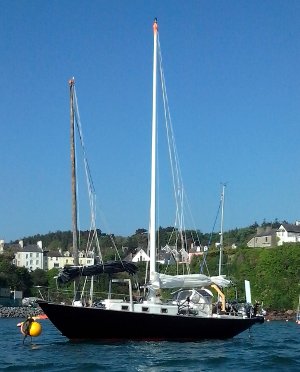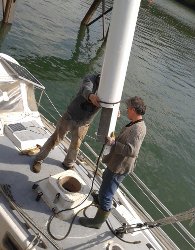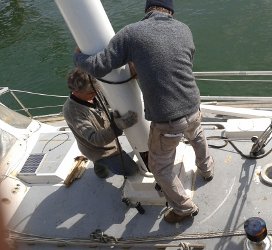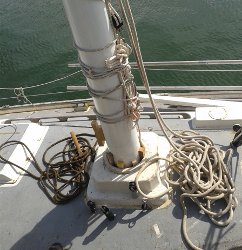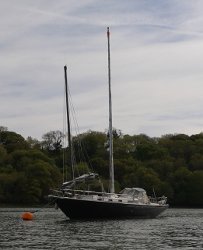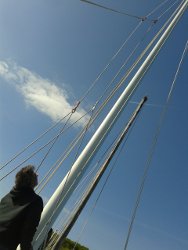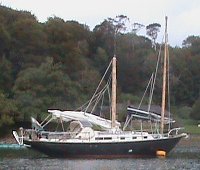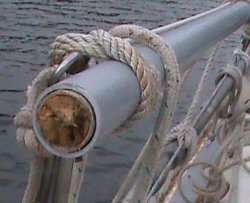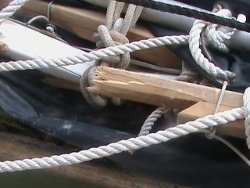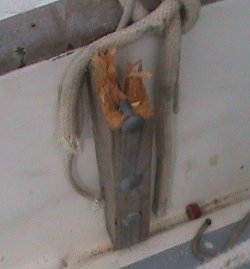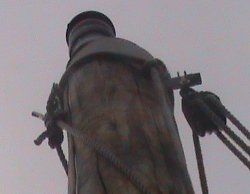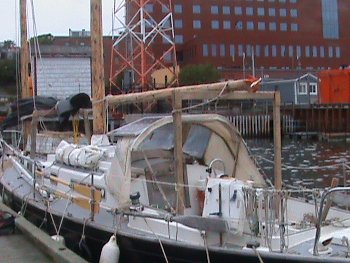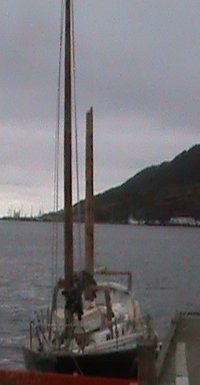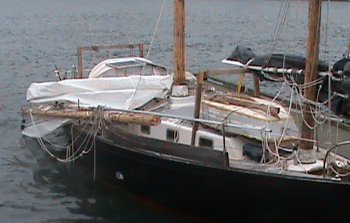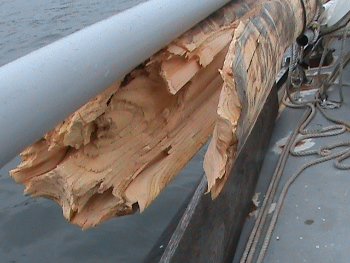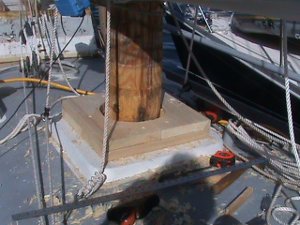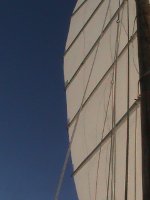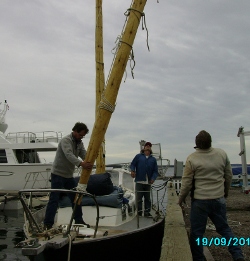A new year and time for new junk-rig masts
Although I replaced my broken Red pine mainmast with a steel pole back in 2013, I have never been very satisfied with it. The 350 kg steel tube was within acceptable limits for the boat, not making it too tender (prone to excessive heeling) – but it had a few drawbacks.
One drawback being its excessive diameter below, taking up too much living space (approx 9″ at the partners increasing to 10.5″ diameter at the step).
Another drawback was its weight – reducing the amount of extra weight that would be reasonable to load on for long distance cruising.
Then there was the nagging worry that so much steel wagging about in big seas would be too much strain on the structural integrity of the hull and deck. This may not have been a strictly rational concern – but it was an emotive one.
And we sail to enjoy, not worry, right?
Another factor in prompting me to install new masts was the fact that I sourced a supplier of aluminium poles only an hours walk over the mountain from where I live. The company, ALC, import aluminium poles from the Netherlands mainly for street lighting uses but were willing to both source and do some custom welding on the poles for me before delivering them to Lawrenny Yacht Station – where the boat is currently moored.
The main mast pole weighs in at 87kg with an 8 inch (199mm) diameter and a wall thickness of 3.5mm. You can view the blueprint for this pole here.
What’s interesting about this pole is that the 8 inch diameter remains constant for the first 18 feet and only then tapers to 76mm at the top. This means that it provides significant strength and resistance when reefed down in heavy weather. It also has the benefit of not unnecessarily increasing in size between partner and step leaving it easier to accommodate down below.
The same is true for the 6 inch diameter foremast pole. It only begins to taper after approximately 9 feet down to a top diameter of 76mm. Wall thickness 3mm. You can view the blueprint if the foremast pole here.
For the masthead cranes I modified an idea forwarded to me via the Junk Rig Association forum. I fabricated two circular discs of 50mm thickness.
The bottom plate had a hole cut out of the center approximately the size of the pole’s top diameter – to allow for wires to be passed up through.
The top plate had a small hole just to let the navigation light wires (mainmast) and VHF cable (foremast) to exit.
The two plates were then bolted together with stainless steel U-bolts from which the masthead lines and blocks were attached.
For extra strength, 6 triangular (10mm thickness) buttresses were welded to the pole and plate. If that sounds all confusing take a look at the picture above of the foremast crane. (I was planning to take more detailed pictures of the design but got too involved in doing it to remember to get the camera.)
Having ordered these poles I was a little concerned that the bare poles by themselves may not provide sufficient strength in extreme conditions – conditions one has to face occasionally when sailing long distance. To assuage this worry I designed and built solid wooden plugs that could be inserted into the poles to extend well above the partners.
The design is based on the fact that given enough force the place where standing masts will buckle (assuming no internal defect in the pole) is at the place of maximum resistance – at the partners where the mast exits the coach roof.
The plugs themselves completely fill the lower internal cavity of the of the poles and then are increasingly reduced in bulk for a further few feet until it is only a 2 inch thick cross contacting the internal pole walls before coming to an end.
The reduction in bulk is to allow a degree of bending of the plugs themselves and mitigate against buckling of the pole at the place of maximum resistance – which would be at the top of the wooden plug – if they remained solid and came to an abrupt stop some 8 feet above the partners.
This design is meant to produce free-standing masts that are a reasonable in size and weight while ensuring sufficient strength and flexibility in the most demanding conditions. Should work ;).
The mainmast now weighs approximately 300lbs (140kg) and the foremast 150lbs (70kg) – including weight of wooden plugs. A reduction of over 450lbs (200kg) of mast weight. The waterline has dropped an inch or more.

main mast being lifted – notice the wooden insert has been squared off to fit neatly into the remade main mast step
The sails and rigging are now refitted with only a few remaining tasks to be completed before sailing off for the summer.
We were originally planning to sail to Lofoten, Norway but time is slipping by and the weather has turned a bit more unfriendly for a spell – so we’ll just have to see how it goes …
Watch this space.

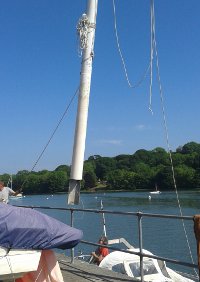








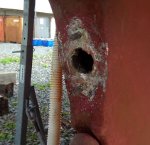
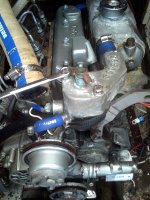
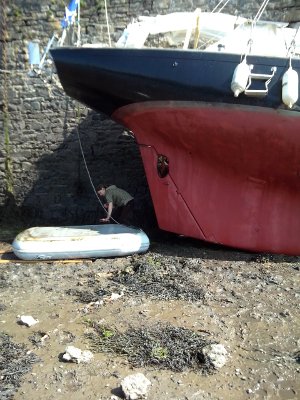
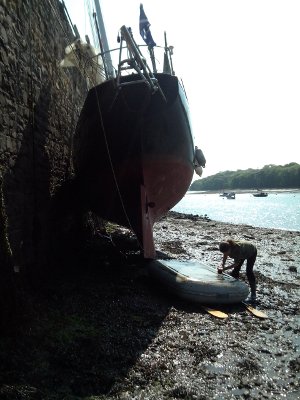 I remember hauling out in Trinidad after spending a month in the Caribbean and a month in west Africa before that. One could hardly see the bottom paint for the encrusted life forms clinging on. After much hard scraping we removed 6 or more 5 gallon buckets completely filled with barnacles – which makes me think there is no bottom paint poisonous enough for those latitudes.
I remember hauling out in Trinidad after spending a month in the Caribbean and a month in west Africa before that. One could hardly see the bottom paint for the encrusted life forms clinging on. After much hard scraping we removed 6 or more 5 gallon buckets completely filled with barnacles – which makes me think there is no bottom paint poisonous enough for those latitudes.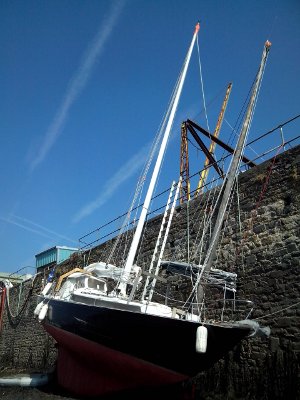 This time around a fast scrub did the trick. I decided not to give it yet another coat of bottom paint as giving it a scrub re-activates the old bottom paint and given these high latitudes and lack of voracious sea-life should prove sufficient for the rest of the summer / autumn (or I least I tell myself that saving me £100+ in bottom paint and mess :)).
This time around a fast scrub did the trick. I decided not to give it yet another coat of bottom paint as giving it a scrub re-activates the old bottom paint and given these high latitudes and lack of voracious sea-life should prove sufficient for the rest of the summer / autumn (or I least I tell myself that saving me £100+ in bottom paint and mess :)).